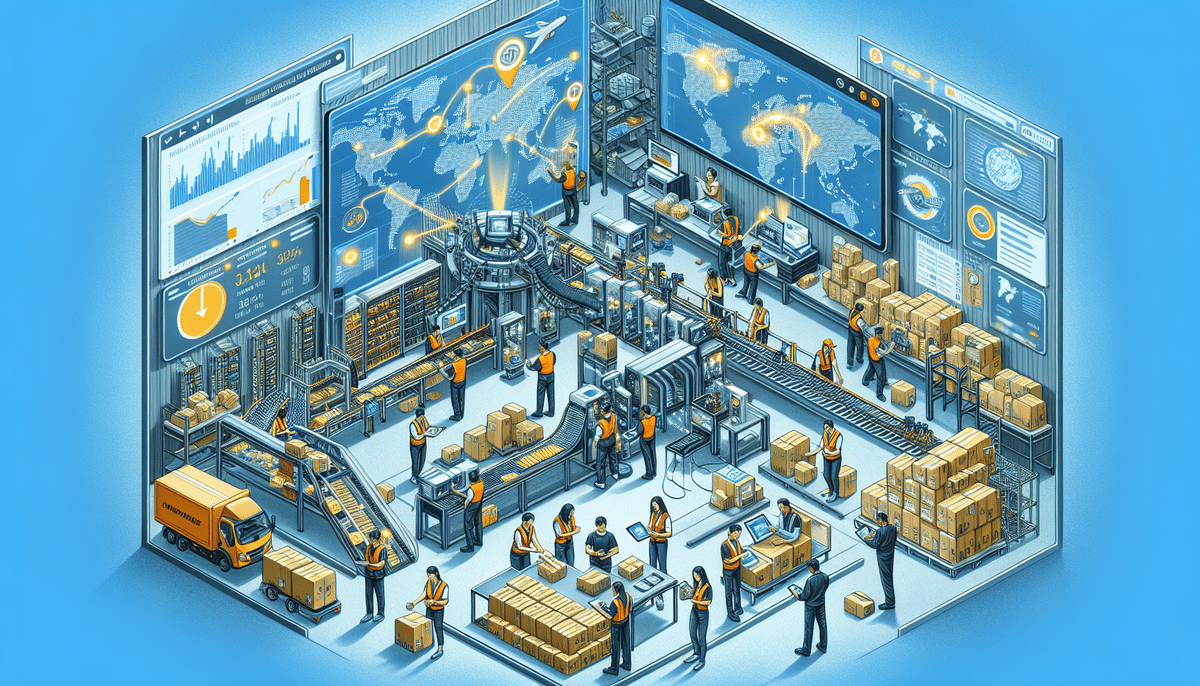Overview and Features of 3PL Logistics Fulfillment: Stock and Ship
In the rapidly evolving world of eCommerce, customer satisfaction is paramount. Today's buyers demand lightning-fast delivery of their purchases, compelling businesses to maintain an efficient order fulfillment process. This is where Third-Party Logistics (3PL) providers come into play. A 3PL provider is an external company that offers logistics services such as warehousing, transportation, and distribution for other businesses. By leveraging 3PL logistics services, companies of all sizes can outsource their logistics needs to professional experts, enabling them to focus on their core business activities.
The Importance of 3PL Logistics in eCommerce
With the explosive growth of eCommerce, online businesses require faster and more efficient order fulfillment solutions. According to a 2023 industry report by Statista, global eCommerce sales are projected to reach $6.4 trillion by 2024, underscoring the need for scalable logistics solutions. 3PL logistics services have become essential in helping eCommerce businesses meet increasing demand by providing reliable, scalable, and cost-effective logistics solutions. By outsourcing logistics functions to 3PL providers, online retailers can concentrate on enhancing their core business activities and gain a competitive edge in the marketplace.
One of the key benefits of using 3PL logistics services is the ability to leverage their expertise and technology. 3PL providers utilize advanced logistics software and tools that streamline the entire supply chain process, from inventory management to order fulfillment and delivery. This results in faster delivery times, improved order accuracy, and higher customer satisfaction rates.
Additionally, 3PL logistics services offer the flexibility to scale operations quickly and efficiently. As online businesses grow, they may need to expand their logistics capabilities to keep up with demand. 3PL providers can support this growth by providing additional resources and infrastructure, such as warehouses, transportation fleets, and skilled personnel, helping businesses avoid the costs and risks associated with building and managing their own logistics networks.
What is 3PL Logistics and How Does it Work?
Services Offered by 3PL Providers
3PL logistics involves outsourcing key operational logistics services to professional logistics providers. These services encompass inventory management, order fulfillment, warehousing, distribution, shipping, and freight forwarding. 3PL companies act as intermediaries between businesses that need logistics and transportation services and the service providers that offer those services. Typically, 3PL logistics companies possess the necessary expertise, infrastructure, and technology to deliver comprehensive logistics solutions.
Advantages of 3PL Logistics
The primary advantage of using 3PL logistics is that it allows businesses to focus on their core competencies, leaving logistics and transportation to the experts. This leads to cost savings, increased efficiency, and enhanced customer satisfaction. Furthermore, 3PL logistics providers often have access to discounted shipping rates and can negotiate better deals with carriers, further reducing costs for businesses. Overall, 3PL logistics offers a valuable solution for businesses aiming to streamline operations and improve their bottom line.
Advantages and Benefits of 3PL Logistics Fulfillment
The benefits of utilizing 3PL logistics for fulfillment are numerous:
- Expertise and Efficiency: Companies can leverage the expertise of experienced logistics professionals who provide cutting-edge logistics solutions.
- Scalability: 3PL logistics solutions allow businesses to scale their fulfillment services according to their needs, resulting in significant cost savings and efficient order management.
- Focus on Core Activities: Outsourcing logistics enables businesses to redirect resources towards core competencies such as product development, customer service, and marketing.
- Access to Advanced Technology: 3PL providers invest in state-of-the-art technology, including warehouse management systems and transportation management systems, enhancing overall operational efficiency.
- Market Expansion: 3PL logistics fulfillment facilitates business expansion into new markets without the need for substantial investment in infrastructure.
By leveraging these advantages, businesses can enhance their operational efficiency, reduce costs, and improve customer satisfaction.
Key Components of 3PL Logistics Fulfillment: Stock and Ship
The core components of 3PL logistics fulfillment include:
- Stock: A 3PL logistics provider receives, stores, and manages a company’s inventory in their warehouse, offering a comprehensive one-stop-shop experience for eCommerce businesses. Effective inventory management is crucial to prevent stock-outs and maintain agility in responding to unexpected product demands.
- Ship: This component handles the transport and delivery of purchased items to customers. A 3PL provider manages shipping infrastructures, carrier partnerships, and repackaging to ensure a seamless shipping process.
- Returns: Managing returns can be complex and time-consuming for eCommerce businesses. 3PL providers handle the entire returns process, including receiving returned items, inspecting them, processing refunds or exchanges, and restocking inventory.
- Customer Service: 3PL logistics providers often offer customer service support, handling inquiries, complaints, and tracking information, thereby enhancing customer satisfaction and retention rates.
How to Choose the Right 3PL Provider for Your Business
Selecting the appropriate 3PL provider is critical for seamless logistics operations. Key factors to consider include:
- Infrastructure and Technology: Evaluate the provider’s infrastructure and technological capabilities to ensure they can meet your logistics needs efficiently.
- Cost Structure: Assess the pricing models to determine cost-effectiveness and suitability for your business size and fulfillment volume.
- Experience and Reputation: Consider the provider’s experience in the industry and their reputation for reliability and customer service.
- Scalability and Flexibility: Ensure the provider can scale operations in line with your business growth and adapt to changing requirements.
- Geographic Reach: If your business operates globally, choose a provider with a strong presence in your target regions to ensure efficient transportation and delivery.
- Customer Service: Opt for a provider that offers responsive and dedicated customer service to address any issues promptly.
By carefully evaluating these factors, businesses can select a 3PL provider that aligns with their logistical needs and strategic goals.
Best Practices for Successful 3PL Logistics Management
Effective management of 3PL logistics involves several best practices:
- Regular Communication: Maintain open and consistent communication with your logistics provider to ensure transparency and efficiency in the supply chain.
- Accurate Inventory Records: Keep precise inventory records to minimize losses due to stock-outs and ensure accurate order fulfillment.
- Leverage Technology: Collaborate with logistics partners to utilize advanced technology solutions that streamline processes, reduce errors, and improve delivery times.
- Establish Clear Metrics: Define performance metrics and key performance indicators (KPIs) to evaluate the effectiveness of your logistics provider and identify areas for improvement.
- Conduct Regular Audits: Perform regular audits of your logistics provider’s operations to ensure compliance with industry regulations and to identify potential risks.
- Continuous Evaluation: Regularly assess your logistics needs and adapt your strategies to stay competitive in the dynamic eCommerce landscape.
Common Challenges in 3PL Logistics and How to Overcome Them
While 3PL logistics offer numerous benefits, businesses may encounter challenges such as:
- Miscommunication: Clear and consistent communication is essential to prevent misunderstandings and ensure smooth operations.
- Lack of Visibility: Implementing real-time tracking systems can enhance visibility across the supply chain, allowing businesses to monitor inventory and shipments effectively.
- Slow Delivery Times: Partnering with a reliable 3PL provider that prioritizes efficient delivery processes can mitigate delays.
- Inadequate Infrastructure: Choosing a 3PL provider with robust infrastructure ensures they can handle your logistics needs effectively.
To overcome these challenges, businesses should foster transparency in their partnerships, integrate with the provider’s technology systems, and select a logistics service provider with a proven track record of efficient and cost-effective fulfillment.
Case Studies: How Businesses Have Benefited from Using 3PL Logistics Fulfillment
Numerous companies have successfully leveraged 3PL logistics fulfillment to enhance their operations:
- Amazon: As one of the world’s largest online marketplaces, Amazon relies heavily on 3PL services to maintain its fast delivery times and manage its vast inventory across global warehouses.
- Shopify: Shopify’s built-in 3PL service provider network supports its users by handling logistics, allowing online retailers to focus on their core processes. This partnership enables Shopify merchants to scale efficiently and reach a broader customer base.
These case studies illustrate the significant advantages that 3PL logistics fulfillment can offer to businesses aiming to optimize their supply chain and enhance customer satisfaction.
Future Trends and Innovations in 3PL Logistics Fulfillment
The logistics and supply chain industry is continually evolving, with technology driving significant transformations. Key future trends and innovations include:
- Warehouse Automation: Automation technologies, such as robotics and automated sorting systems, are increasing efficiency and reducing human error in warehouses.
- Predictive Analytics: Utilizing data analytics to predict demand patterns and optimize inventory management, leading to more accurate forecasting and reduced costs.
- Drone Deliveries: Emerging drone technology promises to revolutionize last-mile delivery, offering faster and more cost-effective shipping solutions.
- Sustainable Logistics: Growing emphasis on sustainability is driving the adoption of eco-friendly practices, such as electric vehicles and green packaging materials.
These innovations are set to disrupt traditional logistics models and redefine 3PL logistics, enabling businesses to achieve greater efficiency and meet evolving customer expectations.
Comparison of In-House vs. Outsourced Fulfillment: Which One is Better?
Choosing between in-house and outsourced fulfillment depends on specific business needs:
- In-House Fulfillment: Offers greater control and visibility over the fulfillment process, potentially leading to better margins. However, it requires significant investment in infrastructure, technology, and quality control measures.
- Outsourced Fulfillment: Provides flexibility, scalability, and a wider range of distribution options, making it ideal for businesses experiencing rapid growth or seasonal spikes. It reduces the burden of managing logistics internally.
Ultimately, the decision should be based on a thorough assessment of business requirements, growth projections, and operational capabilities to determine the most suitable fulfillment approach.
Tips for Optimizing Your Stock and Ship Processes with 3PL Logistics Fulfillment
Optimizing stock and ship processes is essential for operational efficiency and customer satisfaction. Consider the following tips:
- Proper Inventory Management: Implement robust inventory management systems to ensure accurate tracking and prevent stock-outs.
- Incorporate Automation: Utilize automated systems for order processing and inventory tracking to reduce manual errors and increase speed.
- Leverage Technology: Adopt advanced logistics software to streamline processes, enhance visibility, and facilitate better decision-making.
- Optimize Delivery Times: Work with your 3PL provider to establish efficient delivery schedules that minimize shipping costs and improve delivery speeds.
By adhering to these optimization strategies, businesses can enhance their fulfillment operations, reduce costs, and improve overall customer satisfaction.
Integrating Your eCommerce Platform with a 3PL Provider: What You Need to Know
Seamlessly integrating your eCommerce platform with a 3PL provider is crucial for efficient logistics management. Key considerations include:
- Inventory Management: Ensure real-time synchronization of inventory levels between your eCommerce platform and the 3PL provider to prevent discrepancies.
- Order Processing: Automate order transmission to the 3PL provider to expedite fulfillment and reduce processing times.
- Shipping Label Generation: Integrate shipping systems to automatically generate and print shipping labels, streamlining the dispatch process.
- Tracking and Reporting: Implement tracking systems that provide real-time updates to customers and detailed reports for performance analysis.
Successful integration requires careful planning and the selection of compatible software solutions to ensure seamless communication between platforms. Businesses should assess the compatibility of their eCommerce software with their chosen 3PL provider to facilitate a smooth integration process.
Cost Analysis of Using a 3PL Provider vs In-House Fulfillment
Evaluating the costs associated with using a 3PL provider versus maintaining in-house fulfillment is essential for informed decision-making. Factors influencing this analysis include:
- Business Size: Larger businesses may benefit from economies of scale when outsourcing, while smaller businesses might find in-house fulfillment more cost-effective initially.
- Infrastructure Investment: In-house fulfillment requires significant upfront investment in warehousing, technology, and personnel, whereas 3PL providers spread these costs across multiple clients.
- Fulfillment Volume: High-volume businesses may achieve lower per-unit costs through 3PL providers due to their extensive networks and negotiated carrier rates.
- Market Demand: Fluctuating demand can impact the cost-effectiveness of in-house versus outsourced fulfillment, with 3PL providers offering more flexibility to scale operations as needed.
While in-house fulfillment can provide higher margins and greater control, 3PL logistics often result in long-term cost savings through streamlined operations, scalability, and access to a comprehensive range of logistics services. Conducting a thorough cost analysis based on these factors will help determine the most suitable fulfillment method for your business.
Choosing the Right Shipping Carrier for Your Business with the Help of a 3PL Provider
Selecting the appropriate shipping carrier is crucial, as it directly impacts shipping time and delivery costs. A 3PL provider can assist businesses in choosing the right carrier by evaluating factors such as:
- Shipping Volume: High shipping volumes may qualify for discounted rates with certain carriers.
- Geographic Reach: Carriers with a strong presence in your target regions ensure efficient transportation and delivery.
- Package Size and Weight: Different carriers specialize in various package dimensions and weights, affecting cost and delivery speed.
3PL providers maintain extensive carrier networks and have the expertise to negotiate more cost-effective shipping rates than businesses might achieve independently. By leveraging a 3PL provider’s relationships and industry knowledge, businesses can optimize their shipping strategies for better cost efficiency and faster delivery times.
Overall, 3PL logistics can unlock a myriad of opportunities for eCommerce businesses. With the increasing demand for quicker, more efficient order fulfillment solutions, 3PL logistics services offer the scalability, expertise, and technology necessary to maintain a competitive advantage in the market. By focusing on the key components of 3PL logistics fulfillment, businesses can set themselves up for success while maintaining high levels of customer satisfaction.






















